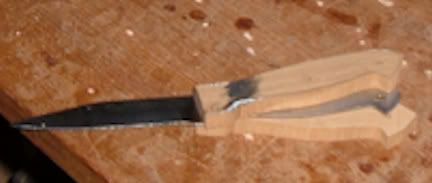devonwoody
Established Member
Yesterday I decided to put a replacement wooden (iroko) handle to this kitchen knife.

I changed the blade down to a 6mm and removed all the guides off the bs except the back bearings.
Switched on and the loudest machine shop bang I have heard, checked my pants were OK , thought the blade had broken, switched off, opened the top door, blade in one piece but behind the wheel, opened the lower door but blade was intact.
It appeared that the blade had spun off the rearside of the top wheel and was intact. Replaced blade back on wheels, same again and another bang. Several more times, it would not stay on drive, previously this blade has performed ok, but to get the blade to stay on course it needed the centre of the top wheel axle connection to be changed to a different setting. Then got machine to cut without those bearings as per picture above.
Put the 18mm blade back on and bearings back, cut a test piece and it was way out. So bad that the fence angle has gone through around 15% and the opposite fence angle.
(Cutting straight again but took some setting up)

I changed the blade down to a 6mm and removed all the guides off the bs except the back bearings.
Switched on and the loudest machine shop bang I have heard, checked my pants were OK , thought the blade had broken, switched off, opened the top door, blade in one piece but behind the wheel, opened the lower door but blade was intact.
It appeared that the blade had spun off the rearside of the top wheel and was intact. Replaced blade back on wheels, same again and another bang. Several more times, it would not stay on drive, previously this blade has performed ok, but to get the blade to stay on course it needed the centre of the top wheel axle connection to be changed to a different setting. Then got machine to cut without those bearings as per picture above.
Put the 18mm blade back on and bearings back, cut a test piece and it was way out. So bad that the fence angle has gone through around 15% and the opposite fence angle.
(Cutting straight again but took some setting up)

































